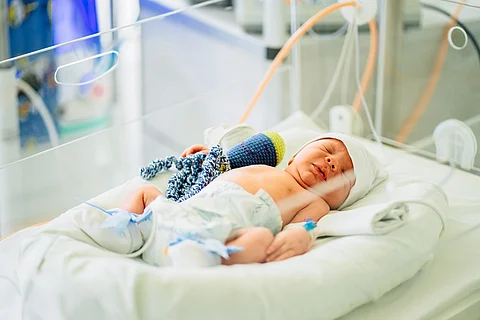

By Dr Pradeep Kumar
A full-term baby was born in Rainbow Children Hospital’s Hebbal branch in Bengaluru. The baby cried soon after birth and was shifted to the mother’s side. After about 12 hours of birth, the baby had an episode of breath holding and sudden jerky movement of upper and lower limbs. The baby was immediately shifted to the Neonatal Intensive Care Unit (NICU) and loaded with phenobarbitone. The baby had repeated episodes of similar attacks and required multiple anticonvulsants. The initial work-up for neonatal seizure like sepsis screen, electrolytes, and cranial ultrasound were normal. Electroencephalography (EEG) showed abnormal background with no sleep wave cycle and features of encephalopathy. Serum ammonia, lactate, TMS, and urine GCMS were normal. Whole exome sequencing showed hyperekplexia Type 3, which is an autosomal recessive disorder.
Hyperekplexia, or startle disease, is a rare non-epileptic disorder characterised by an exaggerated persistent startle reaction to unexpected auditory, tactile, and visual stimuli, generalised muscular rigidity in infancy, and nocturnal myoclonus. So far only 150 cases have been reported in the world.
Startle reflex is a basic alerting reaction consisting of facial grimacing with blinking, followed by involuntary movements of head flexion, hunching of shoulders, adduction of the arms, and flexion of the trunk and the knees, causing falling without a protective reaction. When a pathologically exaggerated startle response interferes with normal activities, causing apnoea and frequent falls and injuries, the pathological state is termed as startle disease or hyperekplexia. Hyperekplexia may occur in a minor form in which the startle response is exaggerated from normal, or in a major form in which patients present with generalised muscular rigidity during the neonatal period.
The aetiology of hyperekplexia is not clear. Hyperactivity of cortical neurons, abnormalities of the inhibitory systems of the brain, and abnormalities of the serotoninergic pathways are among the proposed mechanisms. Subtle brainstem vascular anomaly, pontine infarct, lacunar posterior thalamic-subthalamic infarcts, and brainstem encephalopathy have been reported in adults with hyperekplexia.
Hyperekplexia is usually familial, most often autosomal dominant with complete penetrance and variable expression. Autosomal recessive form and sporadic cases have also been described. The genetic basis is a mutation usually of the arginine residue 271, transforming β alanine and taurine in the glycine receptor from agonists into competitive antagonists. Recently linkage analysis has mapped a gene for this disorder to chromosome 5q33–q35.
Hyperekplexia can present in the foetal life as abnormal intrauterine movements, or later at any time from neonatal period to adulthood. Early manifestations include abnormal responses to unexpected auditory, visual, and somaesthetic stimuli such as sustained tonic spasm, exaggerated startle response, and foetal posture with flexion of forearm and legs, clenched fists, and anxious stare. The tonic spasms may mimic generalised tonic seizures, leading to apnoea and death. These spasms are not accompanied by epileptic discharges on EEG. Additional features are generalised hypertonia and prominent nocturnal/diurnal myoclonus with apnoea. Consistent generalised flexor spasm in response to tapping of the nasal bridge (without habituation) is the clinical hallmark of hyperekplexia. Though usually there is neither mental nor neurological deficiency, features of diffuse cerebral involvement with developmental delay are seen in some patients.
Sudden infant death syndrome (SIDS) is well reported in hyperekplexia. Central apnoea related to brainstem dysfunction or peripheral apnoea after feeding difficulties with consequent aspiration and respiratory muscle spasm are the proposed mechanisms of SIDS. Interestingly, the apnoeic episodes are known to disappear spontaneously by 2 years of age. Sudden death may also be related to complete heart block and apnoea during the seizure-like episodes.
Spontaneous amelioration of the hypertonia with increasing age and delayed gross motor development characterise the evolution of hyperekplexia. Though the tone is usually almost normal by the age of 3 years, hypertonia may recur in adult life. The exaggerated startle response, however, persists to adulthood leading to falls on the face or back without loss of consciousness.
The differential diagnoses of hyperekplexia include the congenital stiff-man syndrome, startle epilepsy, myoclonic seizures, neonatal tetany, and phenothiazine toxicity. Hyperekplexia may also be misdiagnosed as cerebral palsy.
Clonazepam, a gamma aminobutyric acid (GABA) receptor agonist, is the treatment of choice for hypertonia and apnoeic episodes. The degree of stiffness, however, may not be significantly influenced by clonazepam. In contrast, phenobarbitone, phenytoin, diazepam, and sodium valproate have not always consistently controlled the hypertonia and/or abnormal startle response. A simple manoeuvre like forced flexion of the head and legs towards the trunk is known to be life-saving when prolonged stiffness impedes respiration.
Recognition of hyperekplexia in the neonatal period is essential in avoiding erroneous diagnoses like epilepsy. Diagnosis should not be difficult, as consistent generalised flexor spasm in response to tapping of nasal bridge (without habituation) is the clinical hallmark. Though treatment of choice is clonazepam, a simple manoeuvre like forced flexion of the head and the legs towards the trunk can be life-saving in presence of prolonged stiffness compromising respiration. Association with recurrent apnoeic spells, cardiac arrhythmia, SIDS, and severe feeding difficulties with apnoea indicates the need for providing home monitoring and appropriate parental counselling.